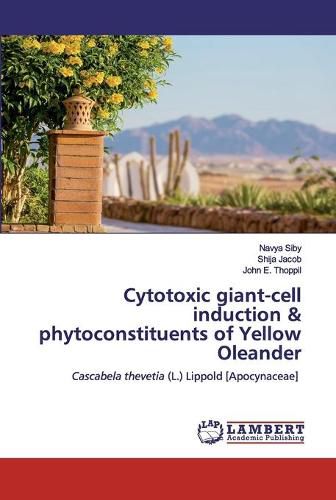Readings Newsletter
Become a Readings Member to make your shopping experience even easier.
Sign in or sign up for free!
You’re not far away from qualifying for FREE standard shipping within Australia
You’ve qualified for FREE standard shipping within Australia
The cart is loading…






This title is printed to order. This book may have been self-published. If so, we cannot guarantee the quality of the content. In the main most books will have gone through the editing process however some may not. We therefore suggest that you be aware of this before ordering this book. If in doubt check either the author or publisher’s details as we are unable to accept any returns unless they are faulty. Please contact us if you have any questions.
This book entitled Cytotoxic giant-cell induction & phytoconstituents of Yellow Oleander, Cascabela thevetia (L.) Lippold [Apocynaceae]
reveals the cytotoxicity of C. thevetia, its phytochemical analysis and in situ visualisation of cell death using Evans blue assay. Yellow oleander, a tropical evergreen shrub is a native of West Indies, Southern Mexico and America. The plant possesses phytoconstituents like alkaloids, flavonoids, phenols, terpenoids, saponins, phlobatannins, steroids, tannins, coumarins, proteins and amino acids. A wide spectrum of clastogenic abnormalities like the giant cells, the strap cells, nuclear budding & lesions, cytoplasmic shrinkage & vacuolation, nuclear & chromosome erosion, apoptotic bodies, nuclear disintegration & extrusion, nuclear diminution, & fragmentation, apoptotic fragmentation of chromatin, nuclear peak formation, pulverization, multiple chromosome bridges, etc. were observed. The non-clastogenic abnormalities scored include micronucleus, bi- & tri-nucleate cells, triple micronuclei, the diagonal arrangement of chromosomes, tripolar anaphase, etc. The study unveils the potential cytotoxic and phytochemical constituents of C. thevetia.
$9.00 standard shipping within Australia
FREE standard shipping within Australia for orders over $100.00
Express & International shipping calculated at checkout
This title is printed to order. This book may have been self-published. If so, we cannot guarantee the quality of the content. In the main most books will have gone through the editing process however some may not. We therefore suggest that you be aware of this before ordering this book. If in doubt check either the author or publisher’s details as we are unable to accept any returns unless they are faulty. Please contact us if you have any questions.
This book entitled Cytotoxic giant-cell induction & phytoconstituents of Yellow Oleander, Cascabela thevetia (L.) Lippold [Apocynaceae]
reveals the cytotoxicity of C. thevetia, its phytochemical analysis and in situ visualisation of cell death using Evans blue assay. Yellow oleander, a tropical evergreen shrub is a native of West Indies, Southern Mexico and America. The plant possesses phytoconstituents like alkaloids, flavonoids, phenols, terpenoids, saponins, phlobatannins, steroids, tannins, coumarins, proteins and amino acids. A wide spectrum of clastogenic abnormalities like the giant cells, the strap cells, nuclear budding & lesions, cytoplasmic shrinkage & vacuolation, nuclear & chromosome erosion, apoptotic bodies, nuclear disintegration & extrusion, nuclear diminution, & fragmentation, apoptotic fragmentation of chromatin, nuclear peak formation, pulverization, multiple chromosome bridges, etc. were observed. The non-clastogenic abnormalities scored include micronucleus, bi- & tri-nucleate cells, triple micronuclei, the diagonal arrangement of chromosomes, tripolar anaphase, etc. The study unveils the potential cytotoxic and phytochemical constituents of C. thevetia.